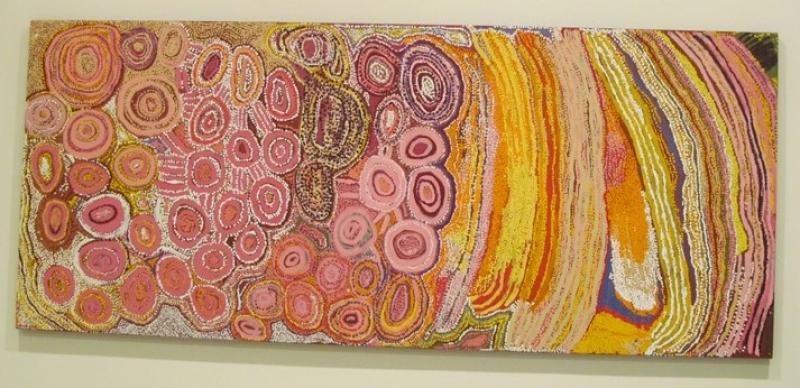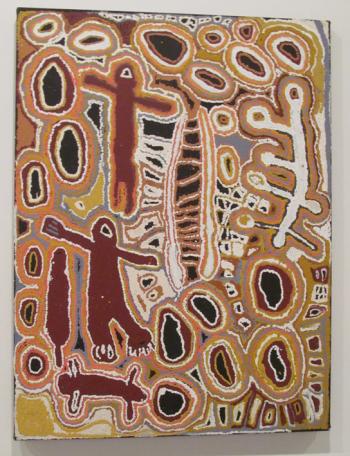Sydney’s Yiribana Gallery
This item appears on page 29 of the February 2021 issue.
For me, Sydney is the gem of Australia, a vibrant city famed for its iconic Opera House and Harbour Bridge and for its proximity to superb ocean beaches, like Manly and Bondi.
Sydney is a relatively young city. British captain James Cook “discovered” the continent of Australia in 1770. Although Portuguese seafarers might have reached Australia 250 years before Cook did, according to some historians, and Dutch seamen arrived in the 17th century at least 150 years before him, it is Captain Cook who is credited with the discovery.
Within 20 years of his discovery, the British established a penal colony at Sydney Cove, between the area of Sydney now called The Rocks and where the Sydney Opera House is located.
Aboriginal Australians
But long before the arrival of the British, the area where Sydney now stands was occupied by the Cadigal, or Gadigal, people, one of several clans called collectively the Eora Nation.
The Eora and other Aboriginal peoples arrived in Australia 50,000 to 60,000 years ago, although some anthropologists claim that it could have been as long as 100,000 years ago. Equally debatable is whether these early peoples arrived in one mass migration or in multiple migrations, where they originally came from and what their migration route or routes might have been from their original homeland.
Current theory favors one mass migration from Africa across Asia and then across relatively shallow waters or land bridges into Australia either via Papua New Guinea or the Malay Archipelago. They hunted, fished and foraged, living in family groups or clans. They were the first Australians.
Aboriginal Australian culture is a rich one, expressed in songs, dances, storytelling and art. Some of that culture is on display in the Yiribana Gallery (phone +61 2 9225 1700, www.artgallery.nsw.gov.au/venues/yiribana), part of the Art Gallery of New South Wales, located across from Sydney’s Royal Botanic Garden on Art Gallery Road.
Understanding the art
Walking into the Yiribana Gallery is like entering an unfamiliar world. Although I’ve visited this gallery many times over the years, it’s always an exploration of new territory for me.
Aboriginal Australian art is unique and — for most non-Aboriginal Australians — difficult to understand. Worth the effort? Certainly. It’s why I keep returning, each time trying to comprehend more than I did before.
Much of Aboriginal Australian art embodies a concept called Dreamtime, or Dreaming, a time when the ancestral spirits of the Aboriginal Australians moved across the land creating all forms of life — plants, animals, geographical features…. These spirits then became part of the landscape they created, becoming themselves the sacred places of Aboriginal Australian culture.
But Dreamtime is not just relegated to the past. It encompasses the present and the future and is an integral part of an Aboriginal Australian’s everyday life and view of the world.
The ancestral spirits live on in legends, song and dance and in the art, so Dreamtime is never-ending and always present.
This can be difficult to absorb and understand, but it’s hard not to appreciate. It’s the layers of meaning in the art presented in the Yiribana Gallery that make it so exciting.
Minyi Puru
One outstanding example is my favorite painting in the present Yiribana Gallery exhibition, a large colorful canvas called “Minyi Puru” (Seven Sisters) painted by Jakayu Biljabu, an Aboriginal Australian from Western Australia.
Her painting is a riot of reds, oranges, pinks and yellows. It’s fascinating to look at just for her use of color. But the colors, dots and swirls have meaning beyond just the vibrant color. They represent a map of where this artist was born — its sand hills, lakes and water holes — all painted in her own “language,” which we, as viewers, can try to interpret.
Future plans
Presently, the Yiribana Gallery is exhibiting a selection of art from its vast collection. It was intended that the gallery be given an expanded space to showcase Aboriginal Australian and Torres Strait art. This was to be completed in 2021 in time for the Art Gallery of New South Wales’ 150th anniversary. Whether that date will be met is debatable. In the meantime, you can still visit the exhibit on Lower Level 3 of the Art Gallery of New South Wales.
The Torres Strait Islands are located between Papua New Guinea and Far North Queensland in Australia. The art of the Torres Strait Islands is also displayed in the Yiribana Gallery, alongside that of the Aboriginal Australians.
The Yiribana Gallery and the Art Gallery of New South Wales are open 10 to 5 Thursday to Tuesday and 10 to 9 Wednesday. Entry is free except for some major temporary exhibitions.
Australian Museum
Another Sydney museum that should be visited in conjunction with the Yiribana Gallery is the Australian Museum (phone +61 2 9320 6000, australianmuseum.net.au). It houses a First Australians exhibit that offers an excellent introduction to past and present indigenous Australian life. It serves also as a way to understand the art exhibited in the Yiribana Gallery.
At the time of my latest visit to Sydney, in February 2020, the Australian Museum, which I’ve visited on every previous trip, was closed for renovation. The renovation was scheduled to be completed by late 2020, but the pandemic may have changed this. It’s best to check before going.
The Australian Museum is located in Sydney’s CBD, or Central Business District, across from Hyde Park at the corner of College and William streets. Before renovation work and the pandemic, the museum was open every day from 9:30 to 5:30.
If you go…
My husband, Paul, and I stayed at the centrally located Fraser Suites Sydney (phone +61 2 8823 8888, sydney.frasershospitality.com), at 488 Kent Street, a high-rise close to almost everything we wanted to see and do in Sydney: Sydney Opera House, Circular Quay boats, The Rocks, Queen Victoria Building, Darling Harbour and, of course, the Yiribana Gallery.
One big plus of staying at the Fraser Suites is the Regent Place Shopping Center food court right next door, with a variety of restaurants serving Asian food, including Japanese, Malaysian, Chinese and Thai.
The elegant Victoria Building, with its classy shops and cafés, is a 10-minute walk away. It’s our favorite place in Sydney for late-afternoon coffee and cake or a light lunch and people-watching. A pianist plays during the day, adding to the genteel atmosphere.
Our stylish one-bedroom apartment at Fraser Suites, with open-plan kitchen/living/dining room, was on a high floor overlooking the city’s skyscrapers and with a glimpse of the harbor. It cost AUD447 (near $344) per night.
Other apartments, ranging from studios to 2-bedroom executive apartments, cost from AUD370 to AUD820 ($285-$631) per night.



